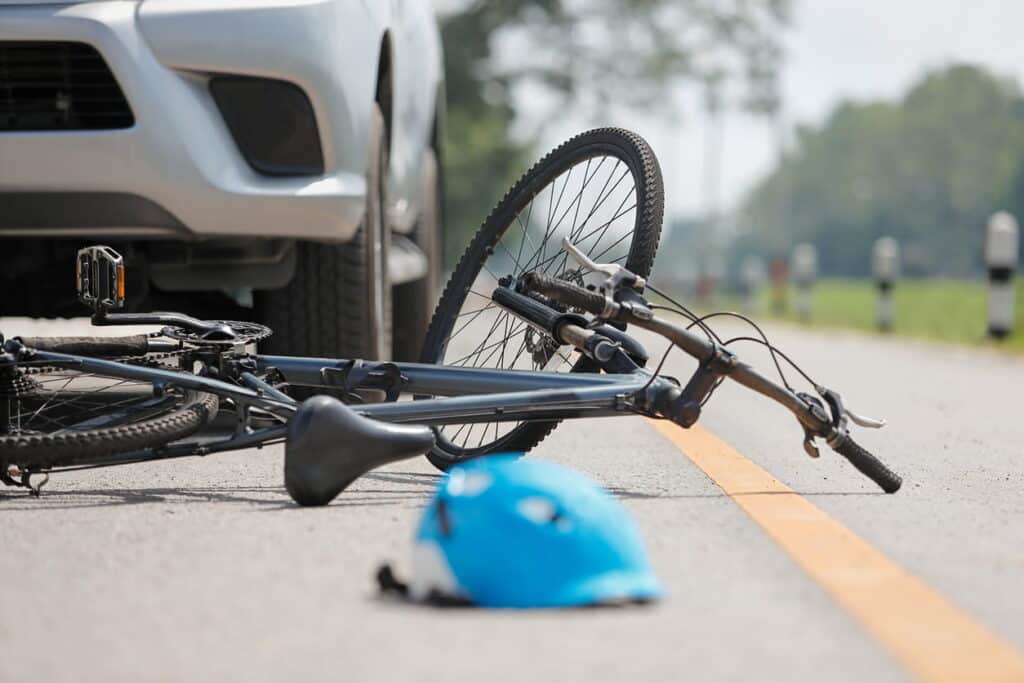When it comes to sharing the road with cyclists, there are some things both drivers and cyclists need to keep in mind to ensure everyone is best able to get to where they are going safely. Here’s what our experienced personal injury attorneys have to say.
START YOUR FREE CONSULTATION
NO FEES UNLESS WE WIN!
Car and bicycle interaction: rules of the road
Let’s face it. Bicycles are highly different vehicles from cars and trucks. Since they aren’t motorized and require manual work to operate, they can’t move as quickly. Furthermore, they are small and more difficult to see. There are some rules cyclists need to keep in mind on the road, including:
- Having reflectors on both their bikes and clothing when riding at night, dawn, dusk, or during inclement weather
- Not riding on sidewalks
- Making eye contact with motorists
- Riding where they can be easily seen
- Being prepared for what’s to come by studying others on the road and paying attention to turn signals
- Riding in a straight line
- Avoiding swerving between parked cars
- Avoiding riding in the door zone of parked cars
- Synchronizing with traffic by staying in the right-hand side of the road with vehicles also headed in their direction
- Checking in front of as well as behind before changing lanes
- Learning hand signals to use for turning
- Crossing railroads at a right angle
- Always being aware of potential dangers such as potholes and debris
- Wearing a helmet
- Carrying tools with you in case your bike should malfunction
- Taking the time to regularly check things such as tire pressure and chain and brake operation

There are also steps that motor vehicle users should keep in mind to best ensure they are properly sharing the road with their cycling counterparts. Between 2012 and 2013, the number of deaths resulting from cyclists being hit by motor vehicles increased by two percent. To help ensure you don’t become a contributor to this grim statistic, ensure you:
- Are aware that not all cyclists are familiar with knowing they are upheld to the same laws on the road governing motorists, so be prepared for unexpected behavior
- Indicate when passing a cyclist of your intent
- Check your blind spots carefully when changing lanes, opening your door, and when preparing to turn
- Travel at a safe distance
- Are especially careful at night, dawn, dusk, or during inclement weather when visibility is more difficult to achieve
- Resist the urge to pass them and instead turn behind them, if needing to turn left and get stuck behind a cyclist
- Use extra caution when roads are wet
Understanding right-of-way
When on the road, you are bound to encounter thousands of unique scenarios, and there are general rules meant to encompass most of them. You should be aware when a motorist or cyclist has the right of way over other vehicles. To make these judgments easier to discern, remember that bicycles are considered “slow-moving vehicles.” This means that those on bicycles are under the rule of the same laws governing motor vehicles. So, if you are at a four-way stop and a bicycle pulls up to your right after you have already come to a complete stop, you have the right-of-way to proceed first.
It’s important to keep in mind that cyclists often include children or others who do not possess a driver’s license. Therefore, they may not be aware of right-of-way laws or not realize there are rules of the road they are expected to obey. After all, you don’t often see bicycles pulled over by police, yet you too often see cyclists engaging in unsafe practices. Therefore, motorists should keep this in mind and always assume the cyclist may do the unexpected.
Cycling signals all should understand

It’s not difficult to tell when a motor vehicle intends to stop or turn as their brake lights and turn signals indicate this is getting ready to occur. For cyclists, however, this is not a possibility. They must learn the common signals to indicate their intentions to others on the road, and it’s the responsibility of everyone on the road to understand these common signals, such as:
- Hand behind the back in a fist indicates a sudden stop
- Right or left arm fully extended and perpendicular to the body indicates a turn
- Right or left arm extended and hand pointing indicates a potential hazard in the direction being indicated
- Arm held at a 45 degree angle with wiggling fingers indicates loose gravel
- Arm behind the back with hand patting buttocks indicates to those behind that they are following too close for comfort for the cyclist
A safe mode of transportation for all to enjoy
Despite the mode of transportation you utilize on the roads, you still must share them with others. Life is busy, and we all have places we need to go. However, few things in life are more unexpected and tragic than a vehicle accident. In 2006, 770 bicyclists perished on roads across the United States, and more than 90 percent involved a motor vehicle. Even if you are a careful driver, you have to keep in mind that others may not be. Therefore, it’s up to each and every one of us to understand the common issues faced on the road in order to share them safely.
Contact our skilled bicycle injury attorneys
If you’ve been in a bicycle accident, our qualified accident attorneys can help. Let our team evaluate your case and guide you through the process. Contact Adam S. Kutner, Injury Attorneys, today to discuss your situation.
Areas We Service in Las Vegas, Nevada
Las Vegas Strip | Henderson | Anthem | Summerlin | Paradise | Spring Valley | North Las Vegas | Summerlin North | Summerlin South | Sunrise Manor | Nellis AFB | Desert Shores | Downtown South | Charleston | Richfield | Crestwood | Angel Park Ranch | Queensridge | Casa Grande Pines | Winchester | West Las Vegas | Green Valley North | Lake Las Vegas | Sun City Summerlin | La Madre Foothills | Tule Springs | Mac Donald Highlands | Green Valley Ranch

Las Vegas Bicycle Accident Testimonial
“My dad recommended me to go to Adam after my accident
The customer service and comunicaron is amazing. I should recommend this office to anyone involved in an accident. They deliver results.”













